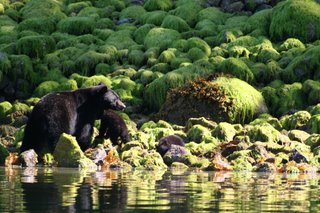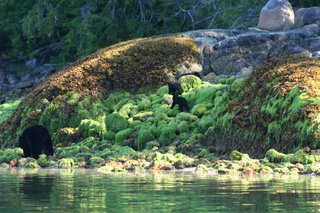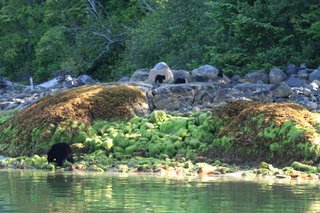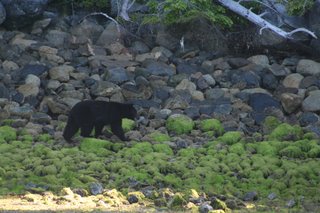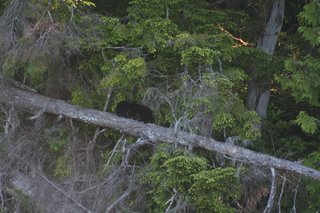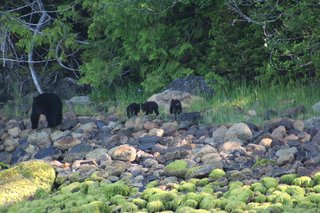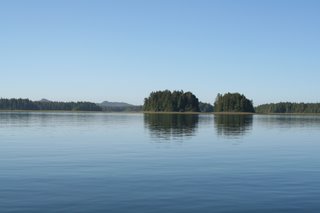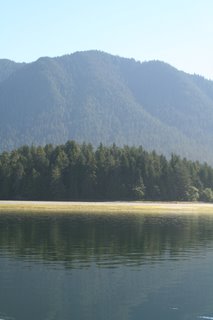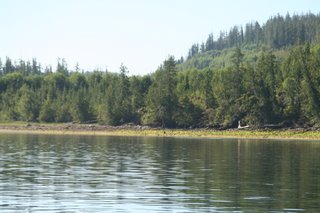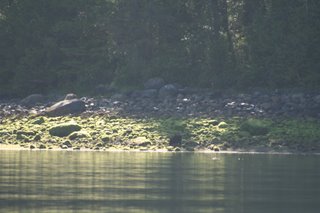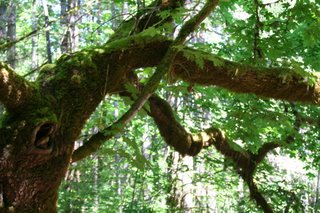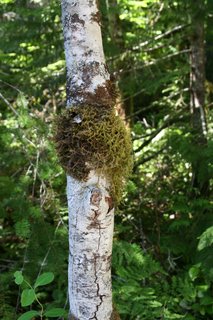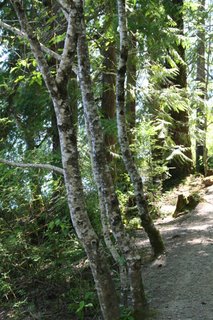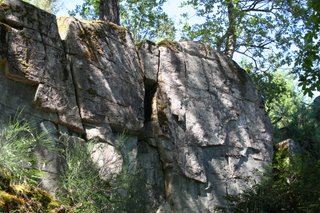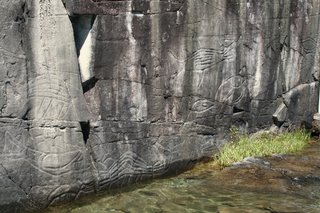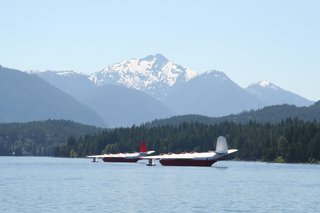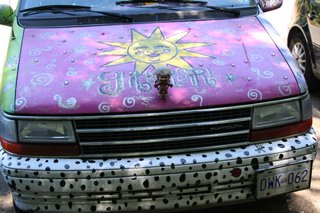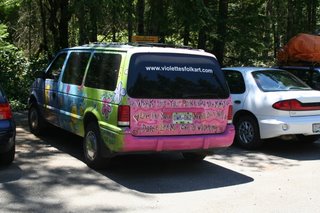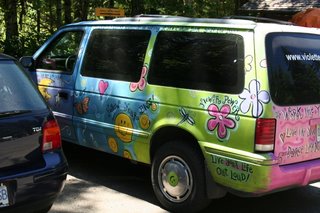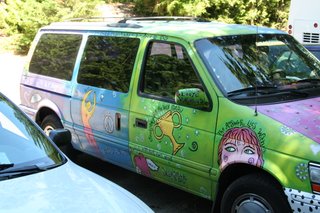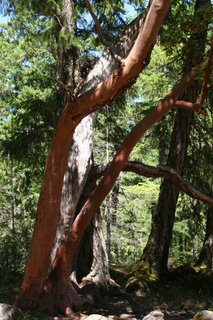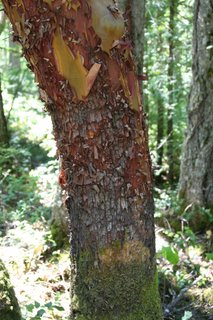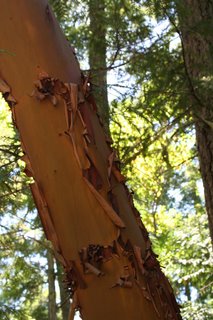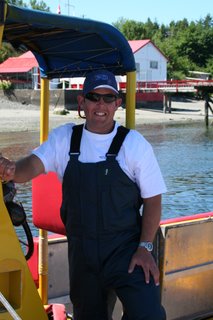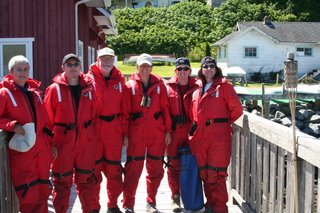On the 25th, before we even went to the Hostel, we stopped at Remote Passages in Tofino to be briefed on the various tour packages on which we would be taken the next day. Tofino is an ecotourism mecca, with many different outfitters and excursion companies. I only have experience with Remote Passages, so please don't interpret what follows as a comparative presentation. Other companies may be equally good; I'm hard pressed to imagine in what way they might be better.
After some close and careful reading of the hold harmless agreement, I and six others signed up for a bear watching tour. Quite a few people signed up for a combined whale-watching and hot-springs tour, and one person signed up for a simple whale watch. We bear-watchers were given a brief explanation of what we should bring with us bright and early in the morning -- we needed to coordinate with the low tide, so that the bears would be out on the beaches feeding. Sun-screen, cameras, snacks, water to drink...
In the morning, we arrived, I with only the one cup of Irish Breakfast for my caffeine, as Tofino sleeps until 9:30, it seems, or at least the section of Tofino where we were. In fact, we arrived before the Remote Passages office opened.
We were shown a series of snippets from television documentaries narrated by David Attenborough, suggesting the nature of what we might see, and then we were each outfitted with red full-body suits which led us all to joke about being part of a NASA shuttle crew. We were given complete, if quick, safety precautions for travel, including instructions in how to close up the suits in case we went overboard. I was loaned a waterproof sack in which to keep my camera gear -- my camera bag barely fit into the sack, which created minor difficulties later on.
Then, down the dock and the gangway we went, onto the zodiac. I sat at the back with the two Australian women, on the starboard, so sometimes photos taken across the boat to port show shoulders or heads of others.
Although we were shown our itinerary on a topographic map before setting out, I'll admit my sense of direction was quickly confused as we travelled out on the water. The Clayoquot Sound, first of all, is comparatively narrow -- something like the Delaware Bay north of Red Banks. It doesn't seem like the ocean, more like a winding river. Second, there are many coves and inlets, so one has the impression of being in a valley with many streams converging. It is difficult to think of the Sound as being an inlet of the Pacific, but the water
is salt, although well-mixed with fresh water flowing out of the hills. At several points we saw the tidal bore where the two flows met each other, the tide flowing in and the stream flowing out.
We were on the water for a bit over two hours, but it seemed longer, there was so much to take in. It was a bright, sunny day, very clear skies, though while we were moving, the "wind of our speed" was sufficient to keep us cool, and I for one was glad to have the suit. When we would stop and drift, however, the suits became uncomfortably hot. On the other hand, when we stopped, we were invariably looking at something interesting, so we weren't paying too much attention to the physical discomfort.
We were told to wait to announce a bear sighting until we were certain we saw movement, "because a lot of times you think you see a bear, but it's just a big rock."
Our first bear sighting -- definitely not a rock -- was of a single individual, probably a male, and at such a distance that ultimately it wasn't that impressive. However, since it was our
first sighting, it was exciting, and I took quite a few pictures which would be sure to elicit comments like, "Is there really a bear in that picture?" The bear was shambling along the stony shore, overturning rocks, apparently oblivious of anything but the task at hand.
Our pilot decided that this particular bear was not as interesting to pursue as might be; he knew of a mother with cubs who was likely to be found in a little bay nearby, so we hurried off in that direction.
Our second sighting was of this bear -- at first we saw only the mother, because the cubs were hidden in a tree back from the beach, but even as we approached with the motor running low, the cubs came out of the woods and scrambled along the beach. Black Bears, it seems, mate early in the year, but fertilization is delayed until the fall; the cubs are born in the winter, about the size of kittens, and continue to nurse for a full year. Towards the end of their first summer they may be starting to eat some solid food, and learning to forage, but most of the change from a milk diet and to a foraging regimen occurs in the second summer, which they spend with their mother; in the fall she drives them off, having mated and now preparing for her next brood. Black Bears typically give birth to twins, less often a single cub, rarely three, and in very exceptional circumstances four.
This second sighting was of a mum with
three cubs, so this was a very happy moment for us. After we had spent what seemed like half an hour, but was probably closer to ten or fifteen minutes, watching the mum and cubs, they went off into the woods, and we motored off in search of more bears. We sighted another mother, at a distance, with a single cub -- this particular bear is notoriously shy; she is young, and this cub is probably her first. We couldn't get close enough for good pictures before she ran off into dense foliage.
We then moved around a headland on which several Bald Eagles were perched in trees; since we passed under them so that the sun was directly overhead as we passed, the pictures I took of them are not impressive. The folks from Europe and Australia were more interested in the eagles than I was; after all, ho hum! I can see Bald Eagles at home in Lancaster County. Yawn.
Next we came into a cobbley bay at the narrows of which a male bear was lying on the beach, seeming completely unaware of us. We were told that bears do not perceive anything coming up from the water as a threat. If people in a boat make a sound, bears do not turn toward the water, but look inland, because it is from
there that they expect an attack -- mostly from other bears! We were able to come within a few metres of the bear before it rose up and began to walk along the shore, rolling over with a single paw cobbles two feet or more in diameter. We could hear the clacking of stone on stone distinctly, and as we drifted closer, we could also hear the bear crunching the mussels it tore from the rocks with its teeth. So far as I can tell, bears eat mussels shell and all, though that seems incredible. This fourth adult gave us quite a show, walking parallel to us (and on the starboard side of the zodiac, which was nice for me), about three or four metres away, and at one point swimming, then climbing out and shaking like a dog (or rather, like a bear) before ambling off into the brush.
We concluded our travels by returning back down the Sound to Tofino by way of an island on which Bald Eagles have built a substantial nest. Considering the size to which eagle nests can grow, this one was not a monster, but it was, as I say, substantial.
We returned to the dock shortly before tea-time, unsuited, and went for a stroll in quest of coffee, which we found in what seems to be something of a specialty of Tofino: a shop combining an outfitter, expedition headquarters, clothier, bookstore, and coffee shop. Just what Pequea in Lancaster County needs! Let the Martic Township supervisors take note!
While sitting on the porch there, drinking cappuccino, I saw several hummingbirds hovering by the foxgloves below the porch. The Swedes thought at first it was some kind of large insect. I forget that hummingbirds are found only in the Americas. I did manage to photograph one of the hummers, but I'm afraid it falls into that category of "There really is a bird in that picture, honest!" I've modified the images slightly so that the bird is larger, but the picture is more grainy than the original.
-- MEA, 1 viii 06
 Cedars moulded by the wind off the Pacific
Cedars moulded by the wind off the Pacific

